Linnea Tanner's Blog, page 32
January 16, 2022
Donovan Cook Raid of the Wolves Coffee Pot Book Club Tour #HistoricalFiction #BlogTour #CoffeePotBookClub @DonovanCook20 @maryanneyarde
For those who enjoy Viking adventure, it is my pleasure to introduce Donovan Cook as part of The Coffee Pot Book Club Blog Tour being held between January 17th – January 21st, 2022. Donovan Cook is the author of the Historical Fiction, Raid of the Wolves (Ormstunga Saga, Book 2) which was independently published by the author on 15th November 2021 (362 pages).
Below are highlights of The Raid of the Wolves and Donovan Cook’s biography.

To follow the blog tour, CLICK Tour Schedule
HIGHLIGHTS: RAID OF THE WOLVES
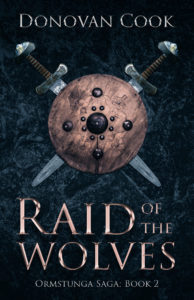
Raid of the Wolves
(Ormstunga Saga, Book 2)
By Donovan Cook
The only thing that kept him going were the voices of his ancestors, screaming for blood…
Ulf and his shield brothers are sent on a raid against an old enemy — Francia, a mighty kingdom to the south, now ravaged by civil war. During the perilous sea voyage, Ulf can only focus on one thing. He demands closure: to find the man who slaughtered his family — Griml.
A hidden enemy stalks Ulf and his warriors through Francia, striking mercilessly when they least expect it. Soon the hunters become the hunted. The Norse warriors must make the ultimate choice between defying the king or angering the gods. Both could end in fury.
But there is another threat lurking in the shadows. One that Ulf could never anticipate.
Ulf is not the only one who wants vengeance.
Buy Links:
Available on #KindleUnlimited
Amazon UK  Amazon US
Amazon US  Amazon CA
Amazon CA  Amazon AU
Amazon AU  Barnes and Noble
Barnes and Noble  Waterstones
Waterstones
AUTHOR BIO: DONOVAN COOK

Even as a young child, Donovan loved reading stories about Vikings and other medieval warriors fighting to defend their homeland or raiding in distant lands. He would often be found running around outside with nothing other than a wooden sword and his imagination.
Now older, he spends his time writing about them. His novels come from his fascination with the Viking world and Norse Mythology and he hopes that you will enjoy exploring this world as much as he did writing about it.
Born in South Africa but raised in England, Donovan currently lives in Moscow, Russia with his wife and their French Bulldog, where he works as an English tutor. When he is not teaching or writing, he can be found reading, watching rugby, or working on DIY projects. Being born in South Africa, he is a massive Springboks fan and never misses a match.
Social Media Links:
Website  Twitter
Twitter  Facebook
Facebook  BookBub
BookBub  Amazon Author Page
Amazon Author Page  Goodreads
Goodreads

Instagram: @coffeepotbookclub
January 12, 2022
Siobhan Daiko The Girl from Portofino Coffee Pot Book Club Blog Tour #HistoricalFiction #WomensFiction #WorldWarIIRomance #WomensHistoricalFiction #ItalianHistorical #HistoricalRomance #CoffeePotBookClub #BlogTour @siobhandaiko @maryanneyarde
To start out the new year of 2022, it is my pleasure to introduce Siobhan Daiko as part of The Coffee Pot Book Club Blog Tour being held between January 3th – January 14th, 2022. Siobhan Daiko is the author of the Women’s Historical Fiction/20th Century Historical/World War 2 Historical Fiction, The Girl from Portofino (Girls of the Italian Resistance: A collection of standalone novels set in Italy during World War 2), which was released by Asolando Books on 30th December 2021 (300 pages).
One of the questions I had is what significance did the Italian resistance have in the outcome of World War II. Below is an enlightening post by Author Daiko entitled, “Significance of the Italian Resistance in World War 2,” which answers my question. Also below are highlights of The Girl from Portofino and Siobhan Daiko’s biography.

For information on the complete tour, CLICK Tour Schedule Page
HIGHLIGHTS: THE GIRL FROM PORTOFINO

The Girl from Portofino
(Girls of the Italian Resistance: A collection of standalone novels set in Italy during World War 2)
By Siobhan Daiko
In 1970 Gina Bianchi returns to Portofino to attend her father’s funeral, accompanied by her troubled twenty-four-year-old daughter, Hope. There, Gina is beset by vivid memories of World War 2, a time when she fought with the Italian Resistance and her twin sister, Adele, worked for the Germans.
In her childhood bedroom, Gina reads Adele’s diary, left behind during the war. As Gina learns the devastating truth about her sister, she’s compelled to face the harsh brutality of her own past. Will she finally lay her demons to rest, or will they end up destroying her and the family she loves?
A hauntingly epic read that will sweep you away to the beauty of the Italian Riviera and the rugged mountains of its hinterland. “The Girl from Portofino” is a story about heart-wrenching loss and uplifting courage, love, loyalty, and secrets untold.
Trigger Warnings:
The brutality of war, death, war crimes against women.
Buy Links:
Available on KindleUnlimited.
Universal Link  Amazon UK
Amazon UK  Amazon US
Amazon US  Amazon CA
Amazon CA  Amazon AU
Amazon AU

Siobhan Daiko is a British historical fiction author. A lover of all things Italian, she lives in the Veneto region of northern Italy with her husband, a Havanese dog and two rescued cats. After a life of romance and adventure in Hong Kong, Australia and the UK, Siobhan now spends her time, when she isn’t writing, enjoying her life near Venice.
Social Media Links:
Website  Twitter
Twitter  Facebook
Facebook  LinkedIn
LinkedIn  Instagram
Instagram  Pinterest
Pinterest  Book Bub
Book Bub  Amazon Author Page
Amazon Author Page  Goodreads
Goodreads
Significance of the Italian Resistance in World War 2
The dramatic political and military changes in Italy during the second half of 1943 forced the Italian people to decide whether to accept or reject the German occupation and the return of fascism. The consequent clandestine struggle of the Resistance was one of the most heroic episodes of the Second World War, a history full of fascinating characters and heart-stirring events, which I have found an inspiration for my writing.
I am a British ex-pat living in Italy. Wherever I go, I am reminded of the Resistance movement of 1943-45. Many main squares or streets bear the name “25 aprile”—the day in 1945 when Italy liberated itself from both Italian fascism and the Nazi occupiers, which is now a national holiday. I have also seen squares and streets named after the many martyrs for the cause.
The Italian Resistance movement went through all the classic stages of development—from passive acts to underground newspapers, escape lines, intelligence, sabotage, assassinations, guerrilla warfare, and, finally, a secret army. The first partisan bands emerged in the mountains as a spontaneous reaction to the German takeover, and they were mainly composed of traditional anti-Fascists, disbanded Italian soldiers, and escaped Allied prisoners of war. The hero of my book, “The Girl from Portofino”, is a British submariner who was held in a POW camp, from where he escaped after the armistice. He, like many, received help from local farmers, who kept him hidden until he joined a group of partisans.
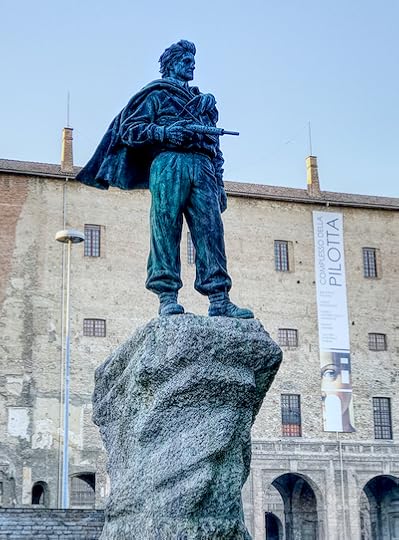
PARMA, ITALY, CIRCA DECEMBER 2017: statue of a partisan in front of Pilotta palace.
Outside Italy most people are unaware of the scale of resistance to Italian fascists and the Nazi occupation. Yet writing in May 1944, Allied commander-in-chief General Alexander calculated those partisan activities in the occupied north had succeeded in pinning down 6 out of every 25 enemy divisions. The resistance forces were so powerful that the Germans had to employ mechanised troops against them. In fact, the Allies relied on the Resistance as part of their Italian campaign and, if the partisans hadn’t been as powerful in engaging the Germans, four extra enemy divisions might have become available for employment on the front against the Allied Armies. After the war, the British Hewitt Report concluded that ‘without these partisan victories there would have been no Allied victory in Italy so swift, so overwhelming or so inexpensive.’
On the opposing side, in August 1944, German commander Field-Marshal Kesselring ordered his troops to ‘tactically put the struggle against the armed bands on the same level as that of front-line warfare’. On 1 October he wrote to all his commanders: ‘Supply traffic is being seriously constrained. Acts of sabotage are growing. We must fight these difficulties with all the means at our disposal … [Partisan] bands have an excellent intelligence network: in most cases they are supported by the Italian people and informed about all German troop movements and preparations.’
It has been estimated that by the spring of 1945 there were 300,000 people actively fighting in the Italian Resistance. Women played an important role. After the war, about 35,000 Italian women were recognised as female partigiane combattenti (partisan combatants) and 20,000 as patriote (patriots). In creating the heroines of my series “Girls from the Italian Resistance” I pay homage to these amazing women.

Partisans parade through the streets of Milan after the liberation.

Instagram: @coffeepotbookclub
January 5, 2022
Skull’s Vengeance Update #HistoricalFantasy #AncientRome #Britannia @linneatanner
I hope everyone had a safe and enjoyable holiday season. For those impacted by the massive fire in Colorado’s Boulder County before the new year, please know that my thoughts and prayers are with you as you recover from the devasting loss. Sad events like this give us pause to embrace the moments of happiness that we share with family and friends.
It had been my hope to release Skull’s Vengeance (Curse of Clansmen and Kings Book 4) in 2021, but the story grew bigger and the characters insisted that I take a different direction from what I had originally planned. Below is an update on where I am in the process of publishing the book.
SKULL’S VENGEANCE UPDATEThe manuscript of Skull’s Vengeance is in the final stages of completion and will be forwarded to my editor by the end of March. After that, I will make the editor’s suggested changes and have the book formatted for publishing. Before I release the book (anticipated in Fall), I will invite my subscribers and other authors/readers to be part of my advance review and/or launch team. More information on these activities will be provided closer to launch.
Below are highlights of Skull’s Vengeance.
HIGHLIGHTS SKULL’S VENGEANCE
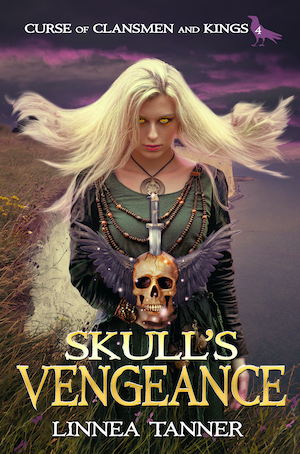
Skull’s Vengeance
(Curse of Clansmen and Kings Book 4)
by Linnea Tanner
(Blurb)
A Celtic warrior queen must ultimately sacrifice what is most precious to her to vanquish her half-brother and reclaim the throne.
AS FORETOLD BY HER FATHER in a vision, Catrin has become a battle-hardened warrior after her trials in Rome’s legion and gladiatorial games. To fulfill her destiny, Catrin must return to Britannia and pull the cursed dagger out of the serpent’s stone. Only then can she unleash the magic of the Druids to destroy her evil half-brother, the powerful sorcerer, King Marrock. Always two steps ahead and seemingly unstoppable, Marrock uses his power to summon destructive natural forces to crush any rival who tries to stop him.
To have the slightest chance of beating Marrock, Catrin must forge alliances with former enemies, but she needs someone she can trust. Seeking military aid from Marcellus, her secret Roman husband, is her only option, which rekindles their burning passion for one another. But Marcellus must play a deadly game in the political firestorm of the Julio-Claudian dynasty to support Catrin’s cause.
In order to destroy King Marrock and take back her kingdom. Catrin must align herself with a Dark Druidess, but she could ultimately lose her heart and soul for the price of the kingdom. Can she strike vengeance against Marrock with a secret weapon from the Otherworld?
ISBN Paperback: 978-1-7336002-0-0
ISBN e-book: 978-1-7336002-1-7
Thank you for your continued support!
Best Wishes,
Linnea Tanner

December 14, 2021
C J ADRIEN THE LORDS OF THE WIND COFFEE POT BOOK CLUB BLOG TOUR #HistoricalFiction #Vikings #BlogTour #CoffeePotBookClub @authorcjadrien @maryanneyarde
It is my pleasure to introduce C. J. Adrien as part of The Coffee Pot Book Club Blog Tour being held on October 13th – December 15th, 2021. C. J. Adrien is the author of the Historical Fiction, The Lords of the Wind (The Saga of Hasting the Avenger Book 1), which was released by Runestone Books on 4th July 2019 (337 pages).
Below are highlights of The Lords of the Wind, C. J. Adrien’s author bio, and my review of his book.

To follow the blog tour, CLICK Tour Schedule
HIGHLIGHTS: THE LORDS OF THE WIND
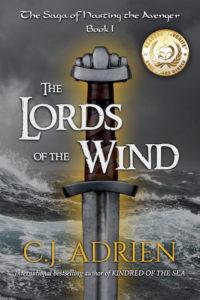
The Lords of the Wind
(The Saga of Hasting the Avenger Book 1)
by C.J. Adrien
Narrator: Gildart Jackson
Orphaned as a child by a blood-feud, and sold as a slave to an exiled chieftain in Ireland, the boy Hasting had little hope of surviving to adulthood. The gods had other plans. A ship arrived at his master’s longphort carrying a man who would alter the course of his destiny, and take him under his wing to teach him the ways of the Vikings. His is a story of a boy who was a slave, who became a warlord, and who helped topple an empire.
A supposed son of Ragnar Lodbrok, and referred to in the Gesta Normannorum as the Scourge of the Somme and Loire, his life exemplified the qualities of the ideal Viking. Join author and historian C.J. Adrien on an adventure that explores the coming of age of the Viking Hasting, his first love, his first great trials, and his first betrayal.
“The Lords of the Wind” by C.J. Adrien is a gold medal winner in the 2020 Reader’s Favorite annual international book award contest.
Trigger Warnings:
Violence
Praise
“If you want to sit down with an extremely well-researched tale involving heroic battles, first loves, and the making of a legend, this book is for you.”
The Historical Novel Society
Buy Links:
This series is available on #KindleUnlimited
The Lords of the Wind (Book 1)
In the Shadow of the Beast (Book 2)
AUTHOR BIO: C. J. ADRIEN

C.J. Adrien is a bestselling and award-winning author of Viking historical fiction novels with a passion for Viking history. His Saga of Hasting the Avenger series was inspired by research conducted in preparation for a doctoral program in early medieval history as well as his admiration for historical fiction writers such as Ken Follett and Bernard Cornwell. He is also a published historian on the subject of Vikings, with articles featured in historical journals such as L’Association des Amis de Noirmoutier, in France. His novels and expertise have earned him invitations to speak at several international events, including the International Medieval Congress at the University of Leeds, the Oregon Museum of Science and Industry (OMSI), conferences on Viking history in France, among others.
Social Media Links:
Website  Twitter
Twitter  Facebook
Facebook  LinkedIn
LinkedIn  Instagram
Instagram  BookBub
BookBub  Amazon Author Page
Amazon Author Page  Goodreads
Goodreads
 The Lords of the Wind by C.J. Adrien
The Lords of the Wind by C.J. Adrien
My rating: 4 of 5 stars
The Lords of the Wind by C. J. Adrien is an action-packed, high sea adventure and a coming-of-age Nordic saga about the early life of Hasting considered one of the most notorious Vikings in the Dark Ages. The story is told through the perspective of Hasting, who describes himself as the Scourge of the Somme and Loire; Christian priests believe he is the Devil sent to punish them for their sins.
As a child, Hasting is enslaved during a blood feud and must endure unspeakable brutality in Ireland until a captain of a warship recruits him to “go a-Viking.” His legend grows after he nearly drowns during a storm but is saved by the mythic, monstrous wolf Eilif. Abandoned by the ship’s crew during a raid in the Britanny region of France, Hasting spends his formative years learning the culture of the Celts and becomes embroiled in their politics. When he discovers that a young woman he loves may have been captured and enslaved by Vikings during a raid, he sets off to rescue her and seek revenge. On his quest to find her, he travels as far north as Norway and transforms into a cunning captain of his own warship.
Author C J Adrien captures the essence of various cultures in the Dark Ages, including the Viking pagans and Celtic and Frankish Christians. The Nordic saga explores the themes of love, betrayal, and political intrigue. The story is most engaging when we learn more about how diverse cultures impact Hasting. He uses broad knowledge from his training, education, and experiences to communicate and negotiate effectively with various factions. Also of interest is the importance of trade during this time, particularly the slave and salt markets.
Mythology seamlessly weaves into the story and captures the beliefs and superstitions of the pagans and Christians. The vivid narrative detailing the landscape, sailing a ship, or processing salt is evidence of the author’s meticulous research. Tragic love and political intrigue drive Hasting’s decisions in the epic adventure on the high seas. However, the last half of the novel felt more rushed with some inconsistencies in the plot and characters which resulted in an unsatisfying ending for me.
I highly recommended The Lords of the Wind to readers who embrace action-packed, epic Viking adventure with a splash of romance and political intrigue on the high seas.

Instagram: @coffeepotbookclub
December 9, 2021
Meredith Allard Christmas at Hembry Castle Coffee Pot Book Club Blog Tour #HistoricalFiction #HistoricalRomance #Victorian #BlogTour #CoffeePotBookClub @maryanneyarde
It’s that time of year to get into the Christmas spirit. What better way to celebrate Christmas than at Hembry Castle?
It is my pleasure to introduce Meredith Allard as part of The Coffee Pot Book Club Blog Tour being held on November 4th – December 10th, 2021. She is the author of the Historical Fiction/Victorian/Holiday novella, Christmas at Hembry Castle (Hembry Castle Chronicles), which was released by Copperfield Press on 1st December 2020 (120 pages).
Below are highlights of Christmas at Hembry Castle, Meredith Allard’s author bio, and an excerpt from her book.

To view the tour schedule page, CLICK Blog Tour
HIGHLIGHTS: CHRISTMAS AT HEMBRY CASTLE
 Christmas at Hembry Castle
Christmas at Hembry Castle
(Hembry Castle Chronicles)
By Meredith Allard
You are cordially invited to Christmas at Hembry Castle.
An unlikely earl struggles with his new place. A young couple’s love is tested. What is a meddling ghost to do?
In the tradition of A Christmas Carol, travel back to Victorian England and enjoy a lighthearted, festive holiday celebration.
Buy Links:
Meredith Allard’s Website  Amazon UK
Amazon UK  Amazon US
Amazon US  Amazon CA
Amazon CA  Amazon AU
Amazon AU  Barnes and Noble
Barnes and Noble  Kobo
Kobo  iBooks
iBooks

Meredith Allard is the author of the bestselling paranormal historical Loving Husband Trilogy. Her sweet Victorian romance, When It Rained at Hembry Castle, was named a best historical novel by IndieReader. Her latest book, Painting the Past: A Guide for Writing Historical Fiction, was named a #1 new release in Authorship and Creativity Self-Help on Amazon. When she isn’t writing she’s teaching writing, and she has taught writing to students ages five to 75. She loves books, cats, and coffee, though not always in that order. She lives in Las Vegas, Nevada. Visit Meredith online at www.meredithallard.com.
Social Media Links:
Website  Facebook
Facebook  Pinterest
Pinterest  Book Bub
Book Bub  Amazon Author Page
Amazon Author Page  Goodreads
Goodreads
The shadows were about again, long along the winding roads, high upon the hills, deep into the valley below, casting a deathly pallor over the tree-lined path leading toward the grand old manor. The castle, known as Hembry in polite society, looked a specter in the night. Accompanying the shadows were the echoes, a sense of a haunting. And why shouldn’t Hembry Castle be haunted? The house was ancient enough to have seen three centuries pass and the comings and goings of more souls than it could ever be expected to remember.
Who knew from whence such sounds came? The old floors groaned under whatever weight crossed them. Church-like beams cracked like decrepit bones as they leaned closer toward each other, ever closer. Certainly, the stately home was well tended and much loved, but still it creaked occasionally as the old will do. If you listen closely you might hear footsteps on the curving stairs, whispers in the halls, and flutters of damask curtains caught in open drafts.
The later the time the more menacing the shadows grew. With the disappearance of the moon behind rain-filled clouds there was little light, leaving long, distorted shapes. Cumbersome trees shed their red, orange, and gold leaves, pointing finger-like branches at the black-looking grass. And still the shadows. Shadows have always provided a good place to hide, especially on a dark autumnal night that threatened wet and cold. Especially for a ghost.
He was a patient ghost, standing back, not wishing to intrude. He hovered near the window and peered into the servants’ hall, squinting through the opaque glass that could have used a good scrubbing, hardly a surprise since the servants were busy polishing and buffing upstairs all hours of the day. The ghost glanced about, perhaps a bit nervously, perhaps not. He knew to take care not to be seen. He was not an iridescent spirit, pale and translucent. Had most people in the castle seen him they would have fainted. Has he come back from the dead, they would ask? Has he been stricken by some preternatural magic that gives life to the lifeless? It was the right time of year for it, certainly, as they headed toward All Hallows’ Eve. Throughout England were those with their fascinations about magnetisms, perceptionisms, spiritualisms, and other isms. Let the family think what they may. Rather, the ghost decided, let me stay out of their sight so they don’t think of me at all. It’s better that way.
The ghost was comforted by the sight of the housekeeper at Hembry Castle along with his dearest niece, both on their way upstairs, back to bed, presumably. The ghost glanced at his pocket watch and shook his head, annoyed by the time. What were they doing awake at this hour? The thought of Daphne, his niece, left him hollow inside. How he wished he could be at her wedding! He could not have wished a better husband for her than Edward Ellis—of that he was certain. Edward and Daphne were perfect for one another. He knew it the first time he saw them together at luncheon at Hembry, the way they gazed at each other until they felt other, intrusive eyes drilling them with relentless curiosity, when they turned tomato-red faces to their wine glasses, which couldn’t be refilled quickly enough.
The ghost moved away from the castle, not floating, merely walking, certain to stay under cover of darkness. He crossed the grounds at a quick pace and found himself on the outskirts near the decorative mock castles and the Greek temple façades. He stopped at the tree-lined avenue, contemplating his childhood home. He exhaled with pride at the dignity of the place, the sand-colored limestone that rose majestically heavenward, as though its very presence had been ordained by a Higher Force. The winding river crackled as it jumped the stones, the water running faster from the constant rains they had been receiving. He turned to leave, the ghost. He meant to be on his way. Though he was still well hidden, the morning sun would break soon and his cloak of invisibility would vanish.
And yet he could not leave. He walked toward the castle once again, close enough to see through the library window. The ghost sighed. He had been cursed by his birth, landed into an earldom he was not suited to. He wanted to travel. He wanted to do what he wanted to do when he wanted to do it. Suddenly, the ghost saw his younger brother, Frederick, looking rather ghost-like himself as he wandered into the library. Seeing Frederick slumped and downcast, rubbing his hands together for warmth since the fire had died away, the ghost felt guilty. Suddenly, every mistake the ghost had ever made weighed on him. Now he, the ghost, was slumped and downcast, feeling the burden of Hembry Castle that he had thrust on Frederick’s shoulders.

Instagram: @coffeepotbookclub
November 30, 2021
HELEN HOLLICK A MYSTERY OF MURDER COFFEE POT BOOK CLUB BLOG TOUR #JanChristopherMysteries #BlogTour #CoffeePotBookClub @HelenHollick @maryanneyarde
Welcome to The Coffee Pot Book Club Blog Tour for author Helen Hollick which is being held from November 22nd – December 3rd, 2021. She is the author of the Cosy Mystery, A Mystery of Murder (Jan Christopher Mysteries, Episode 2), which was released by the Taw River Press on 14th November 2021 (160 pages).
Below are highlights of A Mystery of Murder, Helen Hollick’s author bio, and an excerpt from her book.
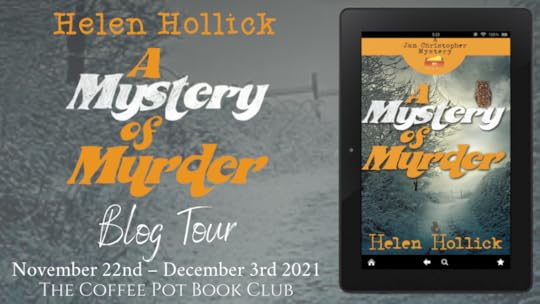
To follow the tour, ClickTour Schedule
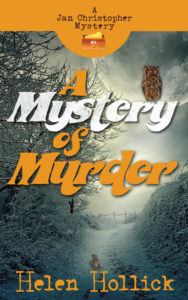
A Mystery of Murder
(Jan Christopher Mysteries, Episode 2)
By Helen Hollick
‘Had I known what was to happen soon after we arrived at Mr and Mrs Walker’s lovely old West Country house, my apprehension about spending Christmas in Devon would have dwindled to nothing.’
Library Assistant Jan Christopher is to spend Christmas with her boyfriend, DS Laurie Walker and his family, but when a murder is discovered, followed by a not very accidental accident, the traditional Christmas spirit is somewhat marred…
What happened to Laurie’s ex-girlfriend? Where is the vicar’s wife? Who took those old photographs? And will the farmer up the lane ever mend those broken fences?
Set in 1971, this is the second Jan Christopher Cosy Mystery. Join her (and an owl and a teddy bear) in Devon for a Christmas to remember. :
Will the discovery of a murder spoil Christmas for Jan Christopher and her boyfriend DS Laurie Walker – or will it bring them closer together?
Buy Links:
Read for free with #KindleUnlimited subscription.
Universal Link  Amazon UK
Amazon UK  Amazon US
Amazon US  Amazon CA
Amazon CA  Amazon AU
Amazon AU  Goodreads
Goodreads

Helen Hollick and her family moved from northeast London in January 2013 after finding an eighteenth-century North Devon farmhouse through being a ‘victim’ on BBC TV’s popular Escape To The Country show. The thirteen-acre property was the first one she was shown – and it was love at first sight. She enjoys her new rural life and has a variety of animals on the farm, including Exmoor ponies and her daughter’s string of show jumpers.
First accepted for publication by William Heinemann in 1993 – a week after her fortieth birthday – Helen then became a USA Today Bestseller with her historical novel, The Forever Queen (titled A Hollow Crown in the UK) with the sequel, Harold the King (US: I Am The Chosen King) being novels that explore the events that led to the Battle of Hastings in 1066. Her Pendragon’s Banner Trilogy is a fifth-century version of the Arthurian legend, and she also writes a pirate-based nautical adventure/fantasy series, The Sea Witch Voyages. Despite being impaired by the visual disorder of Glaucoma, she is also branching out into the quick read novella, ‘Cosy Mystery’ genre with the Jan Christopher Mysteries, set in the 1970s, with the first in the series, A Mirror Murder incorporating her, often hilarious, memories of working for thirteen years as a library assistant.
Her non-fiction books are Pirates: Truth and Tales and Life of A Smuggler. She also runs Discovering Diamonds, a review blog for historical fiction, a news and events blog for her village and the Community Shop, assists as ‘secretary for the day’ at her daughter’s regular showjumping shows – and occasionally gets time to write…
Social Media Links:
Website  Twitter
Twitter  Facebook
Facebook  Amazon Author Page
Amazon Author Page  Goodreads
Goodreads  Blog
Blog  Newsletter Subscription
Newsletter Subscription
Jan Christopher is spending Christmas 1971 with her boyfriend DS Laurie Walker and his parents who live in an old farmhouse in Devon. Evidence of a murder has been found…
A BIT OF A SMELL
I half expected Gran to want to come with us to visit the Haywoods at Upper Valley View – she had already declined to go shopping.
“Goodness, no,” she exclaimed when Laurie asked if she wanted to walk up the lane with us, “my days of trudging up these steep Devon hills are well past. I’ve plenty to occupy myself here.”
“I’ll light the sitting room fire for you, then,” Laurie offered, “if you’re sure?”
“Very sure,” Gran insisted, “I’m half way through Simenon’s La Folle de Maigret, so I’ll be plus de contenu, merci.”
“Très bien, grand-mère.”
I was hopeless at French, so had no idea what they were saying. I smiled, though, and uttered the only French I could remember from school. “Oui!” Well, in all honesty, I also remembered ouvre la porte but ‘open the door’ wasn’t exactly appropriate.
“Is she really reading Maigret in French?” I whispered to Laurie as we left the house.
“Naturellement. She’s fluent in several languages. Including Russian.”
“Oh. Jolly good,” I answered, feeling about as clever as an illiterate ant.
There didn’t appear to be anyone at home when we knocked at the Haywoods’ back door. (I’d already realised that very few people in the country used front doors when making an informal visit.) Borrowing the idea from Reverend Passwith, I’d made the suggestion that we could take Bess for a walk and drop in a Christmas card to the Haywoods, so, all apparently innocent, except Laurie said they never exchanged cards, so we dropped that bit and just used Bess instead.
I enjoyed the walk up the lane, and remarked that it must look lovely in spring and summer. Even this early (late?) there were a few primroses braving the smattering of snow.
“Primroses are very hardy,” Laurie explained, “some clumps have been in situ for over fifty years, re-seeding and regenerating. There’ll be foxgloves, stitchwort, columbine, cranesbill, ragged robin, dog roses and such; come next summer… Loads of daffodils in spring.”
“But daffs are not wild flowers, are they? How do they get there in the first place?”
“Many that you see at the side of busy roads were planted to mark the spot of fatal accidents, but these lane daffodils originate from the Second World War.”
I must have looked puzzled, because he laughed and squeezed my hand that I’d nestled snuggly in his. “Pre-war, Devon and Cornwall were noted for growing daffodils which were sent up to London’s Covent Garden overnight by train. Then the war came and every field that was suitable had to be turned over for growing food – human or animal. The daff bulbs had to be dug up, but, rather than destroy them, many growers dispersed them among the hedgerows. They’ve been there, quietly multiplying, ever since.”
“I can’t imagine someone like Mr Haywood being all sentimental and scattering his daffs,” I remarked as we tied Bess’s lead to the farmyard gate at Higher Valley View and walked into the main yard – avoiding as much of the muck as we could. I was glad Laurie had suggested we don wellington boots.
“Mr Haywood?” Laurie called, several times. No response.
We walked to the nearest dilapidated building, a block of what had once been stables, but were now in various states of broken doors, crumbling walls and holed roofs. Ivy, bramble and weeds filled most of the gaps. Laurie continued to call out. We still received no answer. The furthest, end, stable – the only one which looked relatively solid and intact – had a front ‘wall’ of chicken wire and it stank of something pungent.
As we got closer, my eyes started to water, the stink was so strong.
There were about fifteen or so lithe and sinuous animals inside the pen, climbing up the wire or playing on logs and branches scattered inside. There was quite a bit of debris as well: a shredded blanket, the remains of an old leather shoe, a headless teddy bear with its stuffing spilling out. (I made a mental note to ensure that my teddy, Bee Bear, was safe at home.)
I thought the creatures with their long, thin bodies and tiny eyes could be weasels or stoats; Laurie corrected me.
“These are ferrets from the family of carnivores which include weasels, badgers, otters and mink.”
I giggled. “Aunt Madge used to have a mink coat, I hated it because it smelled.”
A voice behind us made me jump. “Reeked o’ mothballs, I expec’. What you two snoopers want?”
Chloë.

Instagram: @coffeepotbookclub
November 28, 2021
Heidi Eljarbo Fair Mountain Christmas Coffee Pot Book Club Blog Tour #Holiday #heartwarmingchristmas #BlogTour #CoffeePotBookClub @HeidiEljarbo @maryanneyarde
Welcome to The Coffee Pot Book Club Blog Tour for Author Heidi Eljarbo that is being held from October 11th – December 13th, 2021. Heidi Eljarbo is the author of the Holiday Fiction, Fair Mountain Christmas (Heartwarming Christmas), which was independently released by the author on 4th October 2021 (98 pages).
Below are highlights of Fair Mountain Christmas, Heidi Eljarbo’s author bio, and an excerpt from her book.

To follow the tour, CLICK Blog Tour
HIGHLIGHTS: FAIR MOUNTAIN CHRISTMAS

Fair Mountain Christmas
(Heartwarming Christmas)
By Heidi Eljarbo
(Blurb)
Nostalgia and Christmas miracles burn bright in this uplifting and heartwarming story about new beginnings and falling in love under a blanket of stars.
Fair Mountain, December 1972.
A few days before Christmas, Juni’s editor gives her a writing assignment that throws her far outside her comfort zone. She and her terrier, Leo, retreat to her grandparents’ old cabin in the Norwegian mountains in hopes of inspiration. But the trip turns into a heart-wrenching and emotionally challenging encounter.
Memories of Juni’s childhood seep in as soon as she enters the cabin, and as for the writing assignment…what does she know about what children need for Christmas?
Juni’s focus changes when handsome Henry Norheim from Moose Lodge down the hill unexpectedly shows up outside her cottage door. His dedication to family, traditions, and Christmas celebration is contagious, but for Juni, coming out of her lonely shell is easier said than done.
As Juni’s deadline draws closer, and the snowflakes softly swirl down on Fair Mountain, she has to face up to her past, open her heart, and dare to take a step forward.
Will the miracle of Christmas live up to its promise of hope, goodwill, and love this year?
Buy Links:
This novel is available to read with #KindleUnlimited subscription.
Universal Link  Amazon UK
Amazon UK  Amazon US
Amazon US  Amazon CA
Amazon CA  Amazon AU
Amazon AU

Heidi Eljarbo is the bestselling author of historical fiction and mysteries filled with courageous and good characters that are easy to love and others you don’t want to go near.
Heidi grew up in a home filled with books and artwork and she never truly imagined she would do anything other than write and paint. She studied art, languages, and history, all of which have come in handy when working as an author, magazine journalist, and painter.
After living in Canada, six US states, Japan, Switzerland, and Austria, Heidi now calls Norway home. She and her husband have a total of nine children, thirteen grandchildren—so far—in addition to a bouncy Wheaten Terrier.
Their favorite retreat is a mountain cabin, where they hike in the summertime and ski the vast, white terrain during winter.
Heidi’s favorites are family, God’s beautiful nature, and the word whimsical.
Social Media Links:
Website  Newsletter
Newsletter  Twitter
Twitter  Facebook
Facebook  LinkedIn
LinkedIn  Instagram
Instagram  Pinterest
Pinterest  BookBub
BookBub
She turned to Leo. “Do you want to go out and play by yourself?”
The dog jumped up and barked. What a positive creature. He was always ready and happy when she suggested something. She closed the kitchen window and let him outside.
“Hey, you. Don’t go far.”
Leo lapped up snow and ran off to play, chase squirrels, or whatever he did outside. She closed the door and went back to the typewriter. Now to work.
She added a few sentences to the two points she already had and structured the article. Did she want to add a question at the beginning? Should she challenge the readers to think for themselves or merely read for entertainment?
A headline should have no more than seven words. Her editor had chosen the title Five Things Children Need for Christmas. Juni counted the words. She was within the margin.
Next, a simple introduction. As a journalist, she aimed to grab the attention of the reader in the ingress, the first paragraph, and summarize the story in a teasing, inviting way. Juni always wrote that part first. It inspired the entire piece. But not this time. Since she still did not know what to write, she’d wait and do that last.
The byline wasn’t a problem. She typed her name after the colon.
Should she add subheadings or dotted points for the five topics? The mini headlines with a well-rounded text would mean more content, but it would also produce a livelier and more interesting article.
The last paragraph should add a golden finishing touch. Perhaps a quote from an expert or a sentimental phrase to keep the reader wanting more.
Leo barked outside, and she opened the door to let him in. His wooly fur was covered in snow.
“Who are you, and what have you done with my cute dog? You need to thaw, or I’m afraid the Abominable Snowman might come and claim you as his pet.”
Leo hopped inside and shook himself, spreading a vast amount of snow onto the hallway floor. Juni grabbed the towel and rubbed his coat then followed him around the room, wiping up the snow that melted into small puddles on the wooden planks.
As the old wind-up wall clock struck seven, the cassette player stopped, and all the lights went out. The sun had set behind the clouds hours earlier. Immersed in her writing, she hadn’t noticed the weather change. The view from her window had gone from softly falling crystals to a dark and wintry storm. The mountain climate was less welcoming now.

Instagram: @coffeepotbookclub
November 24, 2021
Marian L Thorpe Empire’s Legacy Coffee Pot Book Club Blog Tour #HistoricalFantasy #BlogTour #CoffeePotBookClub @marianlthorpe @maryanneyaryde
It is my pleasure to feature a guest post by Marian L. Thorpe as part of The Coffee Pot Book Club Blog Tour being held from November 8th – November 19th, 2021. Marian L. Thorpe is the author of the Historical Fantasy, Empire’s Heir (Empire’s Legacy, Book VI), which was released by Arboretum Press on 30th August 2021 (438 pages).
The guest post provides the inspiration behind writing Empire’s Heir. Following the guest post are highlights of Empire’s Heir and Marian L. Thorpe’s author bio.

To follow the blog tour, CLICK Tour Schedule Page
GUEST POST BY MARIAN L. THROPEThe Inspiration Behind Empire’s Heir
Empire’s Heir is the sixth book in a series, so it’s hard to talk about the inspiration behind it without giving some background to the series as a whole. I began writing Empire’s Daughter, the first book, with the experience of my mother and two aunts in World War II in mind. Britain drafted women into the forces or other war work, and both my mother and my Aunt Catherine saw active service with the Royal Corps of Signals, serving in France with SHAEF (Supreme Headquarters Allied European Forces) HQ. My Aunt Mary, who had married a Dane and was living in Denmark, became part of the Danish resistance. They had been young women in their twenties when war threatened and began; their lives were disrupted beyond imagining, and they were required to serve, a new experience for women in Britain. I took that scenario, that mix of fear and perceived duty and their determination to help defeat an enemy, and moved it to a world reminiscent of early medieval Britain. But the inciting incident, the beginning of the story, is the same challenge: a general telling the women of his land that they must help defend their land against imminent invasion or face almost-certain defeat. The men alone cannot win this war.
That was the story of the first trilogy: the fifth and sixth books, Oraiáphon and Empire’s Reckoning, look at the aftermath of war: the price paid, whether in victory or defeat, in terms of human lives, changes in society, the loss of independence, political and personal – and the possibility of quiet rebellion.
Empire’s Heir, which takes place twenty-two years after the beginning of the series, and moves the narration partially into the next generation, remains thematically true to the story, in that it looks at the sacrifices people are willing to make for the love of their country and their families. But the inspiration for how that’s presented came from two sources: the life of Queen Victoria, and the bride shows of Byzantium.
Gwenna, one of the title heirs, is eighteen. She is heir to her country’s leadership, although unlikely to inherit for many years. Long before the television series Victoria, I’d read biographies of the British queen, the quietly brought-up heir to an empire who succeeded at eighteen. I would have been about eighteen myself when I read Elizabeth Longford’s biography: Victoria: Born to Succeed; I remember wondering how she could have taken on that role at such a young age, of course comparing myself to her.

Queen Victoria By Franz Seraph Hanfstaengl (1804-1877), Public domain, via Wikimedia Commons
Victoria was expected to marry, to produce heirs, and her choice of consorts was limited. Gwenna isn’t quite in that position, but inevitably, in the early-medieval world of my books, she is a piece in the marriage games of alliances and power. Ésparias, Gwenna’s land, is a client state of the Eastern Empire, and, as Gwenna herself puts it, she has been summoned to Casil, the capital city of the Empire,
“…to witness the investiture of Alekos, son of the abdicating Empress Eudekia, as the Emperor of the East. Alekos was twenty-one, and unmarried, and the invitation had been specific. I, heir to the leadership of Ésparias, must be present.”
I hadn’t needed six years of diplomatic training to decipher that message. Alekos needed a bride, and the Empress thought that bride might well be me.”
I came across the bride shows of Byzantium when I was researching the empresses who helped me shape Eudekia, the Empress of my books. In the eighth and ninth centuries, young women from Byzantium’s empire were brought to the city to compete for the hand of the young man who would become, or already was, Emperor. Usually, this was arranged by the man’s mother.
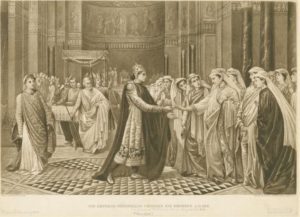
Bride Show By Val Cameron Prinsep (1838-1904) New York Public Library Digital Gallery, Public Domain
The chance to be chosen as the Emperor’s bride was a chance to gain power and influence, both for yourself and for your province or city-state – even possibly to become Empress in your own right after the death of your husband. Historically, the Empresses chose brides for their sons to meet political purposes: my Empress is no different. Gwenna can see the political advantage in marrying Alekos, if she is chosen, and there is something far more personal at stake: her father’s life. But, of course, there are complications, or there wouldn’t be a story.
An advantage – for me – of writing historical fantasy, or second-world historical fiction, as I prefer to call it, as fantasy suggests magic to many people – is that after fifty years of reading history, my head is full of scenarios and events and concepts which I can adapt to my world and my story. So an eighteen-year-old princess in 19th century Britain and a practice from 9th century Byzantium both can be an inspiration for a story taking place in a setting based on 4th century Rome!
HIGHLIGHTS: EMPIRE’S HEIR

Empire’s Heir
(Empire’s Legacy, Book VI)
By Marian L Thorpe
Some games are played for mortal stakes.
Gwenna, heir to Ésparias, is summoned by the Empress of Casil to compete for the hand of her son. Offered power and influence far beyond what her own small land can give her, Gwenna’s strategy seems clear – except she loves someone else.
Nineteen years earlier, the Empress outplayed Cillian in diplomacy and intrigue. Alone, his only living daughter has little chance to counter the Empress’s experience and skill. Aging and torn by grief and worry, Cillian insists on accompanying Gwenna to Casil.
Risking a charge of treason, faced with a choice he does not want to make, Cillian must convince Gwenna her future is more important than his – while Gwenna plans her moves to keep her father safe. Both are playing a dangerous game. Which one will concede – or sacrifice?
Trigger Warnings:
Death, rape.
Buy Links:
Available on Kindle Unlimited.
Universal Link  Amazon UK
Amazon UK  Amazon US
Amazon US  Amazon CA
Amazon CA  Amazon AU
Amazon AU

Essays, poetry, short stories, peer-reviewed scientific papers, curriculum documents, technical guides, grant applications, press releases – if it has words, it’s likely Marian L Thorpe has written it, somewhere along the line. But nothing has given her more satisfaction than her novels. Combining her love of landscape and history, set in a world reminiscent of Europe after the decline of Rome, her books arise from a lifetime of reading and walking and wondering ‘what if?’ Pre-pandemic, Marian divided her time between Canada and the UK, and hopes she may again, but until then, she resides in a small, very bookish, city in Canada, with her husband Brian and Pye-Cat.
Social Media Links:
Website  Twitter
Twitter  Facebook
Facebook  US Amazon Author Page
US Amazon Author Page  UK Amazon Author Page
UK Amazon Author Page  Goodreads
Goodreads

Instagram: @coffeepotbookclub
“*
November 18, 2021
Andrea Matthews Ride with the Moonlight Coffee Pot Book Club Blog Tour #HistoricalRomance #timetravelromance #scottishhistory #borderreivers #CoffeePotBookClub #BlogTour @AMatthewsAuthor @maryanneyarde
It is my pleasure to feature Andrea Matthews as part of The Coffee Pot Book Club Blog Tour being held from November 8th – November 19th, 2021. Andrea Matthews is the author of the Historical, Time-Travel, Romance, Ride with the Moonlight (Thunder on the Moor, Book 2), which was released by Inez M. Foster Publisher on 25th November 2020 (387 pages).
Below are highlights of Ride with the Moonlight, Andrea Matthews’ author bio, and an excerpt from her book.

To follow the blog tour, CLICK Tour Schedule Page
HIGHLIGHTS: RIDE WITH THE MOONLIGHT
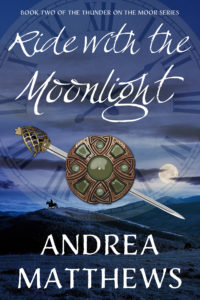
Ride with the Moonlight
(Thunder on the Moor, Book 2)
By Andrea Matthews
(Blurb)
After rescuing sixteenth-century Border reiver Will Foster from certain death at her family’s hands, time traveler Maggie Armstrong finally admits her love for the handsome Englishman, though she can’t rid herself of the sinking suspicion that her Scottish kin are not about to let them live in peace. What she doesn’t expect is the danger that lurks on Will’s own side of the Border. When news of their plans to marry reaches the warden, he charges Will with March treason for trysting with a Scot. Will and Maggie attempt to escape by fleeing to the hills, but when Will is declared an outlaw and allowed to be killed on sight, they can no longer evade the authorities. Will is sentenced to hang, while Maggie is to be sent back to her family. Heartbroken, she has no choice but to return to Scotland, where her uncle continues to make plans for her to wed Ian Rutherford, the wicked Scotsman who she now realizes murdered her father in cold blood. With Will facing the gallows in England, and herself practically under house arrest in Scotland, she continues to resist her uncle’s plans, but her efforts are thwarted at every turn. Will’s family, however, is not about to stand by and watch their youngest lad executed simply because he’s lost his heart to a Scottish lass. A daring plan is set into motion, but will it be in time to save Will’s life and reunite the lovers? Or will Ian’s lies prompt Maggie’s family to ensure the bond between them is forever destroyed?
Trigger Warnings
Violence, sexual content.
Buy Links:
This novel is available on #KindleUnlimited
Universal Amazon Link  Amazon UK
Amazon UK  Amazon US
Amazon US  Amazon CA
Amazon CA  Amazon AU
Amazon AU

Andrea Matthews is the pseudonym for Inez Foster, a historian and librarian who loves to read and write and search around for her roots, genealogical speaking. She has a BA in History and an MLS in Library Science, and enjoys the research almost as much as she does writing the story. In fact, many of her ideas come to her while doing casual research or digging into her family history. She is the author of the Thunder on the Moor series set on the 16th century Anglo-Scottish Border, and the Cross of Ciaran series, where a fifteen hundred year old Celt finds himself in the twentieth century. Andrea is a member of the Romance Writers of America.
Social Media Links:
Website  Twitter
Twitter  Facebook
Facebook  Instagram
Instagram  BookBub
BookBub  Amazon Author Page
Amazon Author Page  Goodreads
Goodreads
Maggie pressed her skirts down and finger-combed her hair, trying to make herself presentable before walking up beside Will. “What’s going on here?”
“I’ve brought a priest for your sinful husband.” Dylan laughed, but Maggie could see the concern in his eyes. “The bloody sod wouldn’t let us in the cell, though.”
“’Tis all right.” Will smiled, though his lips quivered with the strain. “The good father and I will just step over to the left, aye, if ye and Dylan will go as far right as ye can.”
Dylan nodded for Maggie to follow, and she did, knowing Will would want privacy for his last confession. Her heart caught in her throat, tears welling in her eyes. Dylan reached through the latticed bars to touch her arm.
“I’ve brought something for you as well, love.” He dug in a bag he was carrying and pulled out the amulet.
Maggie gasped, the tears bursting forth from their precarious barrier and trickling down her cheeks. They could leave this awful place, return to the twentieth century, but wait . . . “Do you have the chest as well?”
Dylan grinned. He thrust his hand in the bag again and pulled out the jeweled chest. “I told Cuddy the good father needed them for confession.” He shrugged. “Forgive me, Father . . .”
Maggie shoved her arm through the bars, pulling Dylan’s face close, and kissed his cheek. Laughter bubbled up in her chest for the first time in days. “Didn’t Cuddy question it? I mean, he must have been to confession at some time in his life.”
“Yes, well, it’s not as widespread along the Borders as you may have imagined, but he did wonder about them. I told him the items were usually in the confessional box with the priest, so of course he wouldn’t have noticed them.”
“And he believed you?”
Dylan’s grin broadened. “I look like a bloody choir boy. What do you think?”
“Hmm.” Maggie smiled and wiped the tears from her cheeks. “You look like a rogue, but I think I love you anyway.”
“Well, don’t be telling Will. He has a wicked left hook.” The grin dropped from his face. “I’ll leave the chest on the ground and open it just before we leave. Make sure to stand next to it and hold Will’s hand. Godspeed, love.”
“But what about you?” A sudden panic turned her body cold. “You’ll be stuck here with no way home.”
“I told you once, Maggie. The twentieth century holds nothing for me. Here, I have Annie and a family who cares.”
“But you know what happens in the future.”
“I’ll be careful, do what I need to. If my parents ask, though I’m sure it won’t be more than a passing curiosity, tell them I moved to the States. They’ll just be glad I’m out of their hair.”
“I’ll miss you, Dylan.”
“And I you, but we have no choice. The alternatives are too horrible to consider.” Will was blessing himself, so Dylan stepped back and gave a nod to Maggie before addressing his friend. “Are you done, then? Surely that must have been the condensed version.”
“Ye’re a swine, ye ken that, Dylan Hetherington.” Tears clouded Will’s eyes, and he reached out to clasp Dylan behind the neck. “Ye and Annie see Maggie to Lancashire, aye?”
Dylan nodded, but for once in his life, he seemed unable to speak.
“Now,” Will continued. “D’ye think ye can marry us, Father, proper like?”
The priest hesitated. “I dinna ken. Nae banns have been read, and . . .”
“They’re hanging me in the morn, Father. I’ve nae time for banns. Maggie and I have already made our pledges, but we had nae witness, save ourselves and the Lord. I dinna want there to be questions after I’m gone.”
“Have ye cleansed yer soul yet?” Cuthbert was walking down the corridor in their direction.
Dylan met him halfway. “A few more minutes, please, me laird. He does have a lot to confess after all.”
Cuthbert scoffed. “Aye, I suppose he does, the murdering swine.” He looked pointedly at Will. “Tell him to combine his transgressions or something, eh, for I’ll give but ten minutes more. Absolved or no’, the two of ye are on yer way after that.”
“Thank you, me laird.”
“Aye, well, ’twill have to be quick, then.” The priest turned to Will. “D’ye take this lass to yer wedded wife and there unto plight thy troth, under the laws of God and this kingdom, till death ye do part?”
“Aye, Father, I do with all me heart.”
“And ye, lass, ye take him the same?”
“I do, Father.” Maggie’s voice cracked as she said the words. She’d dreamed of Will all her life, since she’d seen his portrait in her father’s collection of sixteenth-century reivers. And now, after traveling over four hundred and fifty years into the past and negotiating a slew of heartache, they were finally together, and this was how their story was to end? No—thanks to Dylan, they would have a chance at life and love. But they needed to hurry before that douchebag keeper, or whatever he was, returned.
“I dinna suppose ye’ve a ring?” Father Joseph asked.
“Here, take this.” Dylan handed him a small ring with a ruby set in it. “’Twas a gift for Annie, but I’m sure she won’t mind.”
“Ye’ll be asking me father for her hand, then?” Will broke into a broad grin.
“Perhaps one day.” Dylan blushed a perfect shade of pink and cleared his throat. “I just want to be ready should I decide to pop the question. Now can we get on with this before Carnaby makes another appearance?”
Will suppressed his grin and took the ring, placing it over Maggie’s finger. “Take this ring as a sign of my love and fidelity.”
“I now pronounce ye husband and wife,” Father Joseph said.
“Right!” Dylan bent down and, in one swift move, opened the chest and yanked the priest toward the stairway. Will frowned and started to call after them, but a sudden gust of wind caught his attention. Maggie pulled him to herself, pressing his head into her shoulder. In a few moments, they would be home. But what would Hexham gaol look like in the twentieth century? Closing her eyes, she sighed and waited for the doors of time to sweep them through their portals.
“Hold up there!” a voice shouted from the other end of the corridor.
Maggie opened her eyes, convinced she would find herself facing a man in twentieth-century garb who would be completely disconcerted about their sudden appearance in a closed historical site. But when she looked through the bars, her heart sank and she gasped for air.
There before her stood Cuthbert Carnaby, holding her precious chest, its lid closed tight. “God’s teeth!” he said. “Ye think a priest would remember to take his gear with him. What am I supposed to do with it now?”
“Maggie,” Will said. “Are ye all right, lass? Ye’re pale as a ghost. D’ye want Cuddy to fetch ye a tankard of ale?”
Get ahold of yourself, Maggie. Both men were talking, but their voices seemed muffled and far away. Cuthbert was asking if she needed something stronger. Will was trying to soothe her. She had to take control of the situation. She began to take deep, slow breaths, her hand clasped tight around Will’s arm. That’s right, Maggie. Calm yourself. Now think of a story so you can get that chest and try again.
“Maggie! Maggie!” A voice was calling her name. Was it her father? She blinked to clear her vision, and little by little, Will’s face came into focus.
“Give her a drink of this.” A kindly guard handed something through the bars, and Will lifted her head from his lap, urging her to drink.
Whisky! She sat up, grabbing on to Will for support, and tried to catch her breath.
“Are ye all right, then, lass?” Cuthbert asked.
She blinked again, and a wave of nausea swept over her. Cuthbert Carnaby stood behind the gaoler, still holding the chest. A light sweat broke out on her forehead, and she rested back against Will. “I’m sorry,” she said between the lingering sobs. “It’s all just hitting me. This is real. I’m not going to wake up from some horrid dream.”
Cuthbert softened his expression and shook his head. “Nae, mistress. ’Tis all too real, I’m afeard.”
“The chest. Father didn’t leave it behind. He wanted me to have it . . . to put some of Will’s hair in . . . and the cross he wears beneath his jack . . . and other things I could remember him by.”
Cuthbert frowned. “I’m afeard I canna let ye have it, lass, no’ unless I broke it apart to make sure nowt was hidden in it. I’ll keep it, though, so ye can take it with ye when ye go to Scotland. In the meantime, I’ll get ye a sack to keep those things in.” He nodded to Will and headed back down the hallway, her last hope held tight in Cuthbert’s arms.

Instagram: @coffeepotbookclub
November 16, 2021
Tammy Pasterick Beneath the Veil of Smoke and Ash Coffee Pot Book Club Blog Tour #HistoricalFiction #PittsburghHistory #PennsylvaniaHistory #BlogTour #CoffeePotBookClub @TammyPasterick @maryanneyarde
Welcome to The Coffee Pot Book Club Blog Tour for Author Tammy Pasterick which is being held from September 21st – November 23th, 2021. She is the author of the Historical Fiction, Beneath the Veil of Smoke and Ash, which was released by She Writes Press on 21st September 2021 (371 pages).
Below are highlights of Beneath the Veil of Smoke and Ash, Tammy Pasterick’s author bio, and an excerpt from her book.

To follow the blog tour, CLICK Tour Schedule Page
HIGHLIGHTS: BENEATH THE VEIL OF SMOKE AND ASH

Beneath the Veil of Smoke and Ash
By Tammy Pasterick
(Blurb)
It’s Pittsburgh, 1910—the golden age of steel in the land of opportunity. Eastern European immigrants Janos and Karina Kovac should be prospering, but their American dream is fading faster than the colors on the sun-drenched flag of their adopted country. Janos is exhausted from a decade of twelve-hour shifts, seven days per week, at the local mill. Karina, meanwhile, thinks she has found an escape from their run-down ethnic neighborhood in the modern home of a mill manager—until she discovers she is expected to perform the duties of both housekeeper and mistress. Though she resents her employer’s advances, they are more tolerable than being groped by drunks at the town’s boarding house.
When Janos witnesses a gruesome accident at his furnace on the same day Karina learns she will lose her job, the Kovac family begins to unravel. Janos learns there are people at the mill who pose a greater risk to his life than the work itself, while Karina—panicked by the thought of returning to work at the boarding house—becomes unhinged and wreaks a path of destruction so wide that her children are swept up in the storm. In the aftermath, Janos must rebuild his shattered family—with the help of an unlikely ally.
Impeccably researched and deeply human, Beneath the Veil of Smoke and Ash delivers a timeless message about mental illness while paying tribute to the sacrifices America’s immigrant ancestors made.
Buy Links:
Amazon UK  Amazon US
Amazon US  Amazon CA
Amazon CA  Amazon AU
Amazon AU  Barnes and Noble
Barnes and Noble  iBooks
iBooks  Bookshop.org
Bookshop.org  Books-A-Million
Books-A-Million

A native of Western Pennsylvania, Tammy Pasterick grew up in a family of steelworkers, coal miners, and Eastern European immigrants. She began her career as an investigator with the National Labor Relations Board and later worked as a paralegal and German teacher. She holds degrees in labor and industrial relations from Penn State University and German language and literature from the University of Delaware. She currently lives on Maryland’s Eastern Shore with her husband, two children, and chocolate Labrador retriever.
Social Media Links:
Website  Twitter
Twitter  Facebook
Facebook  Instagram
Instagram  BookBub
BookBub  Amazon Author Page
Amazon Author Page  Goodreads
Goodreads
Work in the mill makes a man old before his time. That was what the grown-ups in Sofie Kovac’s neighborhood always said. She thought of this tired expression as she studied the figure of a man hobbling across the courtyard behind her house. He was barely visible in the early morning fog, but seemed to be headed for the communal privy just steps from her back porch. He was a steelworker, like her father, but looked much older. He shuffled along slowly, clutching his knee with each labored step. Sofie crossed herself, praying her father wouldn’t suffer the same fate.
She refocused her attention from the window back to the bacon grease. It flowed, like liquid gold, from the cast iron frying pan into the Mason jar she struggled to keep steady on the kitchen counter. She had dropped Aunt Anna’s grease jar once before and watched the precious drippings from a week’s worth of meals slide between the cracks in the floorboards. She shuddered at the thought of repeating that mistake.
Aunt Anna had lectured her for days about the value of all those flavorings now resting permanently in the dirt beneath the kitchen floor. “Like tossing coins into the river,” her aunt had scolded.
Sofie held her breath and tightened her grip on the jar as the last few drops of grease plopped from the frying pan onto the hardening pile of sludge—the key ingredient in all her aunt’s recipes. The pan now empty, she let out a sigh of relief.
“Do you need some help, zlatíčko?” Papa asked, his footsteps growing louder as he neared the kitchen counter.
Sofie shook her head. “The bacon’s a little crispy. I left it on the stove too long. If Mama hadn’t distracted me—”
“You never told me why you’re making breakfast this morning instead of your aunt,” Papa said, changing the subject.
“I had a nightmare. I couldn’t get back to sleep, so I told Aunt Anna I’d do the cooking today.”
“You’re so thoughtful,” Papa said as he bent to kiss Sofie on the forehead. “Do you want to tell me about the nightmare? Sometimes it helps to talk about it.”
“No, not really.” Suddenly, a haunting image flashed before Sofie’s eyes. Her father’s lifeless body lay on the ground in front of a furnace, blistered and burnt. It was the same disturbing vision that appeared in her sleep every few weeks. Why was it now tormenting her in the light of day?
“So what’s for lunch?”
“Bacon sandwiches, leftover fried cabbage, and an apple,” Sofie said as she fidgeted with the items in her father’s beat-up tin lunch bucket. It was badly dented and covered in grime, but one of her favorite things. Seeing that bucket on the kitchen counter always made her happy. It was proof that her father was home safe from the mill.
Once Papa’s lunch was packed, Sofie filled two plates with eggs and bacon and placed them on the wobbly kitchen table. She sat down across from her father, who was extinguishing the oil lamp. He looked tired, his eyes still heavy with sleep. A ray of sunlight pouring through the kitchen window accentuated the gray in his freshly combed hair, making him look older.
Sofie stared at the tattered brown shirt her father wore. He’d ripped off its sleeves since his work in front of the furnace was so terribly hot. In fact, anytime Aunt Anna bought him a new shirt at the second-hand store, Papa promptly tore off the sleeves and gave them back to her for use as cleaning rags. How Sofie wished Papa could wear a suit to work every day. He’d be so much safer in an office job. She slammed her glass of water onto the table, startling herself.
“Are you all right?” Papa asked. “What’s got you so upset? The nightmare?”
Sofie nodded. “Mama, too,” she grumbled as she shoved a fork full of eggs into her mouth. She wasn’t even hungry. She was still angry about her mother’s lame excuse for not joining them at the neighbors’ that evening. The Sears Catalog? Sofie never understood why her mother spent so much time staring at clothing she couldn’t afford.
“I’m sorry your mother hurt your feelings.” Papa patted Sofie’s hand. “That happens too often.”
Sofie wondered whether Mama had hurt his feelings, too. She’d angrily brushed Papa’s hand away when he’d laid it on her shoulder. Mama always ignored his affections. Sofie couldn’t remember the last time she saw her parents share an embrace. They were so different from the other couples in the neighborhood. The Lithuanians across the street acted like they might never see each other again when the husband left for the mill each morning.
“Why don’t you tell me about your dream,” Papa said, stroking Sofie’s hair.
She laid down her fork and studied her father’s concerned face. She hated bothering him with her troubles. He had a fair amount of his own.
“I’m listening.”
Sofie could no longer resist the urge to confide in her father. “It was the same one I always have—you’re at work in the mill, in front of your furnace. And there’s an accident . . .” Sofie’s eyes filled with tears. “It’s a little different every time, but the ending is always the same.” She began to cry.
Papa reached across the table and pulled Sofie into his arms. He rubbed her back as she buried her face in his chest. “You need to stop worrying about me. The mill is dangerous, but I’m careful. I have years of experience.”
“Will you please quit?” Sofie pleaded, looking up at her father. “Can’t you find a safer job?”
“I wish I could, but only the mills and mines will hire immigrants,” he said, shaking his head.

Instagram: @coffeepotbookclub



